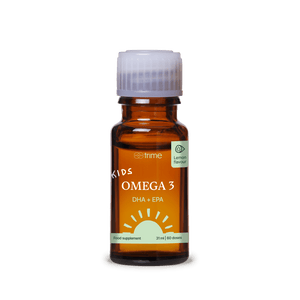In today's article, we will focus mainly on the omega-3 fatty acids EPA and DHA and in which cases to choose one or the other fatty acid form.
Omega-3s are polyunsaturated fatty acids and the most important are alpha-linolenic acid (ALA), eicosapentaenoic acid (EPA) and docosahexaenoic acid (DHA). These fatty acids intervene in a large number of biochemical pathways and processes in the human body and play an important role in maintaining our health. There is a growing number of studies that point to the fact that omega-3 fatty acids are beneficial to prevent for example cardiovascular, neurodegenerative or arthritic diseases.
Article at a glanc:
- EPA, DHA and ALA
- When to choose EPA and when DHA?
- EPA and inflammation
- DHA for healthy brain development
- DHA during pregnancy
- DHA and healthy eyes
- Digestion of omega-3 fatty acids and why to supplement them together with food containing fat?
Omega-3 EPA, DHA and ALA
Docosahexaenoic acid (DHA) and eicosapentaenoic acid (EPA) are omega-3 fatty acids that are obtained mainly from marine sources, specifically from seaweed or from cold-water fish such as salmon, sardines or mackerel. In contrast, alpha-linolenic acid (ALA) is primarily found in plant sources (for example, in flaxseed or walnuts) and can be converted to EPA and DHA. Unfortunately, this conversion is not sufficient, and because omega-6 fatty acids use the same enzymes in their metabolic pathway, a diet high in omega-6 fatty acids reduces the conversion of ALA to EPA and DHA. For this reason, we are focusing on eicosapentaenoic acid and docosahexaenoic acid in this article.
When to choose EPA and when DHA?
The topic of the biological functions of individual omega-3 fatty acids types is very complex. In general we can say that DHA is a structural acid found in the human brain, skin and retina and may be more suitable for people dealing with, for example, neurological problems. On the other hand, EPA supports a healthy immune response by stimulating the production of eicosanoids, which help reduce inflammation.

EPA and inflammation
Inflammation is a natural and necessary reaction of the organism to damage. It can be caused, for example, by pathogenic microorganisms, by chemicals or physical injuries. Acute inflammation fulfills a protective function in the body and helps heal acute trauma. The problem arises in the case of chronic inflammation, which is long-lasting. The professionals point to the connection between chronic inflammation and civilization diseases. EPA acts as a precursor of anti-inflammatory eicosanoids (such as prostaglandins type 3, thromboxanes type 3 and leukotrienes), which reduce the body's inflammatory response. EPA may therefore be a more appropriate choice for people suffering from pain or swelling, which point to signs of inflammation.
A scientific article named "Omega 3 Fatty Acids and Inflammatory Processes" [1] lists some diseases that are associated with the body's inflammatory response, where omega-3 fatty acid supplementation may be beneficial. These include, for example, atherosclerosis, cardiovascular disease, obesity, rheumatoid arthritis, Crohn's disease, ulcerative colitis, lupus, type 1 diabetes, cystic fibrosis, asthma and allergies, chronic obstructive pulmonary disease, psoriasis, multiple sclerosis or neurodegenerative diseases.
DHA for healthy brain development
As mentioned above, DHA is an important building block of the brain and affects communication between neurons. This fatty acid is very important during pregnancy for the normal growth and development of the fetal brain and also in the first few years of life when the brain develops rapidly.
DHA during pregnancy
Research from 2018 [2] showed that DHA supplementation during pregnancy reduces the risk of premature birth and also the risk of low birth weight of the newborn. DHA supplementation is useful not only for the child, but also for the mother. A 2020 study [3] found that DHA may prevent depression in late pregnancy and the early postpartum period.
DHA and healthy eyes
DHA is a structural component of the retina of the eye and is thus essential for healthy eye development. According to some studies, DHA can also help improve certain eye conditions, such as dry eyes or diabetic retinopathy. A 12-week 2018 study [4] of contact lenses wearers concluded that daily omega-3 fatty acid supplementation reduced contact lens discomfort. Another study [5] found that daily omega-3 fatty acid supplementation for 3 months resulted in a reduction in eye pressure in normotensive adults. Increased eye pressure is a risk factor for the development of glaucoma, a disease that gradually impairs vision.
Digestion of omega-3 fatty acids and why to supplement them together with food containing fat?
Fats are naturally hydrophobic (= they are not soluble in water) and therefore must first undergo emulsification, followed by lipolysis. Fatty acids are emulsified in the small intestine with the help of bile acids. Emulsified fats are further broken down by lipolytic enzymes produced by the pancreas (primarily lipase), whose release and activity is stimulated by the fat content in our meals.
The resulting products are formed into structures called micelles. Micelles are absorbed into the cells of the intestinal epithelium, where they become part of fat particles - chylomicrons. Chylomicrons are further absorbed into the blood through the lymphatic system, from where they travel to the liver and other tissues in the body.
Sources
[1] Calder PC. Omega-3 fatty acids and inflammatory processes. Nutrients. 2010 Mar;2(3):355-374. doi: 10.3390/nu2030355. Epub 2010 Mar 18. PMID: 22254027; PMCID: PMC3257651.
[2] Jackson KH, Harris WS. A Prenatal DHA Test to Help Identify Women at Increased Risk for Early Preterm Birth: A Proposal. Nutrients. 2018 Dec 6;10(12):1933. doi: 10.3390/nu10121933. PMID: 30563193; PMCID: PMC6316227.
[3] Zhang, MM., Zou, Y., Li, SM. et al. The efficacy and safety of omega-3 fatty acids on depressive symptoms in perinatal women: a meta-analysis of randomized placebo-controlled trials. Transl Psychiatry 10, 193 (2020).
[4] Downie LE, Gad A, Wong CY, Gray JHV, Zeng W, Jackson DC, Vingrys AJ. Modulating Contact Lens Discomfort With Anti-Inflammatory Approaches: A Randomized Controlled Trial. Invest Ophthalmol Vis Sci. 2018 Jul 2;59(8):3755-3766. doi: 10.1167/iovs.18-24758. PMID: 30046817.
[5] Downie LE, Vingrys AJ. Oral Omega-3 Supplementation Lowers Intraocular Pressure in Normotensive Adults. Transl Vis Sci Technol. 2018 May 1;7(3):1. doi: 10.1167/tvst.7.3.1. PMID: 29736322; PMCID: PMC5931260.


















